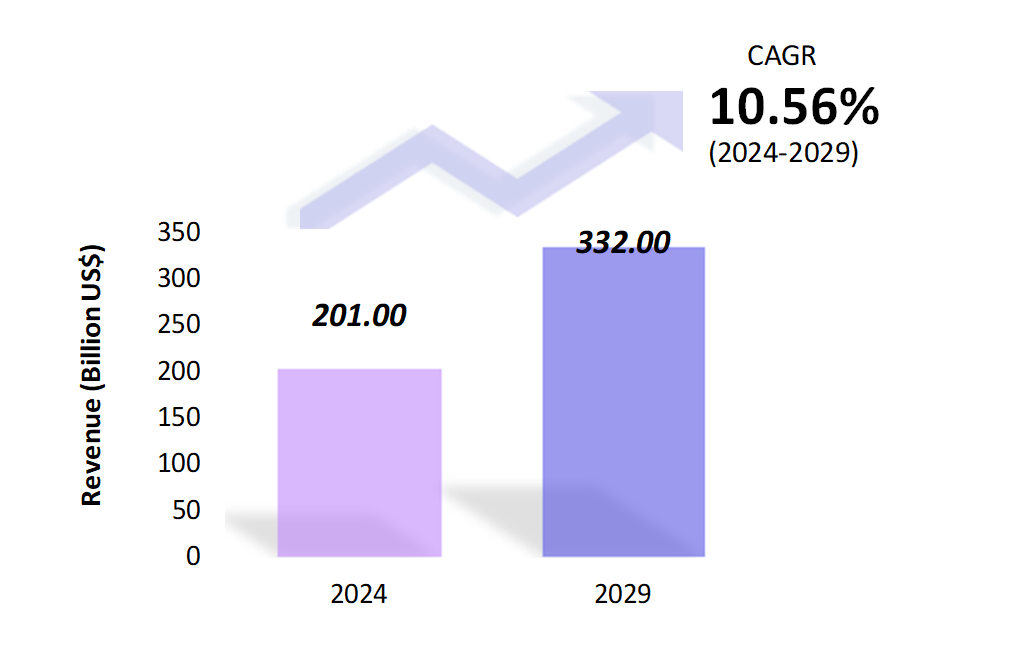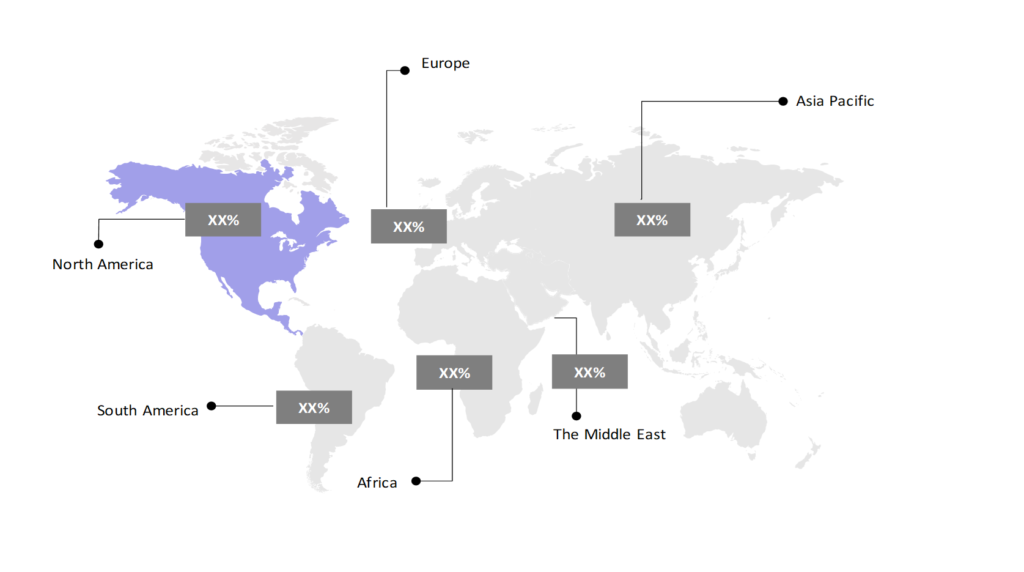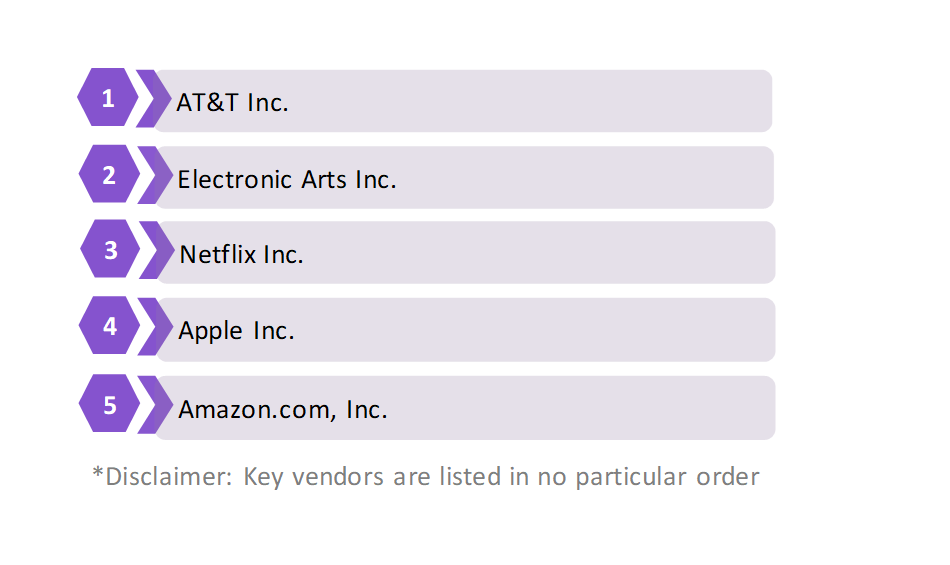Mobile Entertainment Market Outlook: Size, Share, Trends & Growth Analysis (2024-2029)
The report covers a comprehensive analysis segmented by Application Type (Mobile Music, Mobile Gaming, Mobile Tv, Mobile Personalization), By Advertisement Type (Social Media Advertising, Online Video Advertising, Online Search Advertising, Mobile Location Based Advertising), By Geography (North America, South America, Asia Pacific, Europe, the Middle East, Africa).
Mobile Entertainment Market Snapshot

Mobile Entertainment Market Overview
The market for mobile entertainment is projected to grow from $201 billion in 2024 to $332 billion in 2029. For the projection period of 2024–2029, the worldwide mobile entertainment market is growing at a compound annual growth rate (CAGR) of 10.56%.
The mobile entertainment market is growing, driven by the popularity of smartphones, improved mobile connectivity, and the widespread demand for mobile entertainment. The global mobile phone market is worth billions of dollars every year and is expected to continue growing at a healthy pace. Technological enhancements, such as quicker processing speeds, enhanced display capabilities, and higher resolutions, enable mobile devices to deliver entertainment with greater efficiency and effectiveness. Recent technologies such as augmented reality (AR), virtual reality (VR) and 5G connectivity are expected to power mobile entertainment and open new possibilities for developers as well as content creators.
Mobile entertainment services often adopt a variety of business models, including subscription models (e.g., Netflix, Spotify), sponsorship models (e.g., YouTube, social media platforms), freemium models (e.g., mobile games with in-app purchases) and business models (for example, purchasing or renting digital content). Mobile entertainment services are available worldwide, but local efforts to diversify the audience across regions, languages and cultural preferences are important. Localization will change the content, user interface, and marketing strategy to meet the specific needs and preferences of the local market.
Mobile Entertainment Market Coverage
| Historical & Forecast Period | 2018-2029 |
| Base Year | 2023 |
| Forecast Period | 2024-2029 |
| Units | Billion US$ |
| Segments | Application Type, Advertisement Type |
| Geographies | North America, South America, Asia Pacific, Europe, The Middle East, Africa |
| Key Vendors |
AT&T Inc., Electronic Arts Inc., Netflix Inc., Apple Inc., Amazon.com, Inc. |
Key Geographies of Mobile Entertainment Market, 2023

Porter’s 5 Forces Analysis of Mobile Entertainment Market

Mobile Entertainment Market Trends
Video, music, and game streaming platforms continue to dominate the mobile entertainment market. Services such as Netflix, Spotify, YouTube, and gaming platforms such as Apple Arcade and Google Stadia have experienced significant growth, driven by the increasing popularity of smartphones and high-speed mobile internet. Live streaming platforms such as Twitch and Facebook Live are popular for gaming broadcasts, live events, concerts, and immersive content. These platforms enable instant interaction between creators and viewers, improving the overall entertainment experience. The scope of mobile games continues to expand, with various games appealing to distinct groups of people and hobbyists.
The rise of virtual reality games, augmented reality (AR) games, and massively multiplayer online battle arena (MOBA) games is driving the growth of the mobile entertainment market. Mobile entertainment platforms strive to be accessible and inclusive by offering features such as subtitles, audio descriptions, and editing capabilities for users with disabilities. These standards are designed to ensure that entertainment content reaches a wider audience. Short-form video platforms like TikTok and Instagram Reels have gained immense popularity by providing users with a platform to create and consume small entertaining videos. These platforms are influential in shaping online culture and trends.
Mobile Entertainment Market Driving Factors
Business technology on mobile devices is becoming more efficient, including improvements in processing power. Features such as augmented reality (AR), virtual reality (VR) and advanced gaming capabilities are increasing the appeal of mobile entertainment. Different contents in different genres, formats and languages attract the attention of many customers for mobile entertainment. Streaming platforms, gaming apps, social media and content creation tools provide a vast library of entertainment options to suit a variety of tastes and preferences.
Subscription-based and freemium business models are driving revenue in the mobile entertainment industry. Subscription services offer ad-free content, exclusive features, and premium experiences through recurring payments, while freemium apps offer basic features for free with the option of in-app purchases, or premium upgrades. The growth of mobile gaming and esports has contributed greatly to mobile entertainment. Mobile games attract the attention of many players by offering a variety of gaming experiences, from casual and hyper-casual games to competitive games. The rise of content creation tools and platforms is encouraging the richness and diversity of mobile entertainment by allowing users to create and share content. User-generated content (UGC) platforms like TikTok and Instagram Reels foster a culture of creating and consuming content by encouraging creativity and self-expression.
Mobile Entertainment Market Challenges
The mobile entertainment space is competitive and fragmented, with many platforms competing for users’ attention. Content creators, app developers, and service providers face intense competition for audiences, making it difficult for them to stand out and attract users. Additionally, the fragmentation of the platform across different devices, functions, and app stores creates challenges for developers and consumers. One of the main problems facing the mobile entertainment industry is the existence of illegal content in categories such as movies, music, games, and e-books. Piracy not only affects the income of content creators and publishers, but also damages intellectual property rights and reduces the incentive to invest in original content.
Mobile entertainment systems must address competition issues, including monitoring and maintaining social standards, preventing the spread of harmful or illegal content, and addressing issues such as hate speech, misinformation, and online violence. Balancing freedom of expression with the need to provide a safe and inclusive environment for users is difficult. Keeping up with rapidly evolving technology and consumer preferences poses challenges for the mobile entertainment industry. Adapting to new platforms, models and technologies such as augmented reality (AR), virtual reality (VR), 5G connectivity and blockchain-based distribution models requires continuous development, innovation and investment.
Mobile Entertainment Market – Key Industry News
- In March 2024, Zonar Systems Inc., a major player in marine health and safety, announced the launch of Zonar MyView in Canada. MyView is a new app that provides parents and guardians with instant location updates and bus details for their children every day.
- In March 2024, AllSaints Music Group, announced that the company will bring 360 Reality Audio, an immersive music experience utilizing Sony’s object-based 360 Spatial Sound technology, to hundreds of millions of Android mobile phone users and potentially EV users via AllSaints Immersive music service worldwide.
- In November 2022, OnMobile Global Ltd., a leader in mobile gaming and entertainment, partnered with Robi Axiata Ltd., Bangladesh’s fastest 4.5G network, to launch its mobile gaming product Challenges Arena.
Mobile Entertainment Market Competitive Landscape
The participants in the global mobile entertainment industry are always developing their strategies to preserve a competitive advantage. Companies primarily use acquisitions, R&D, partnerships, and technological launches. Several important entities in the mobile entertainment market include AT&T Inc., Electronic Arts Inc., Netflix Inc., Apple Inc., Amazon.com, Inc. and others. Alongside global giants, there are also regional players and startups that compete with larger rivals, offering local content and services that cater to specific businesses or niche interests.
Overall, competition in the mobile entertainment industry is fierce, with companies vying for customer satisfaction, trust, and revenue through a combination of relevant content, user experience and new features. The market continues to evolve with technological advances, changing consumer preferences and current trends shaping the future of mobile entertainment.
Mobile Entertainment Market Company Share Analysis, 2023 (%)

Mobile Entertainment Market – Key Companies

Reason to Buy from us

Table of Contents
| 1. Introduction |
|---|
| 1.1. Research Methodology |
| 1.2. Scope of the Study |
| 2. Market Overview / Executive Summary |
| 2.1. Global Mobile Entertainment Market (2018 – 2022) |
| 2.2. Global Mobile Entertainment Market (2023 – 2029) |
| 3. Market Segmentation |
| 3.1. Global Mobile Entertainment Market by Application Type |
| 3.1.1. Mobile Music |
| 3.1.2. Mobile Gaming |
| 3.1.3. Mobile TV |
| 3.1.4. Mobile Personalization |
| 3.2. Global Mobile Entertainment Market by Social Media Advertising |
| 3.2.1. Online Video Advertising |
| 3.2.2. Online Search Advertising |
| 3.2.3. Mobile Location Based Advertising |
| 4. Regional Segmentation |
| 4.1. North America |
| 4.1.1. The U.S. |
| 4.1.2. Canada |
| 4.1.3. Mexico |
| 4.2. South America |
| 4.2.1. Brazil |
| 4.2.2. Argentina |
| 4.2.3. Colombia |
| 4.2.4. Chile |
| 4.2.5. Rest of South America |
| 4.3. Asia Pacific |
| 4.3.1. China |
| 4.3.2. India |
| 4.3.3. Japan |
| 4.3.4. South Korea |
| 4.3.5. Rest of Asia Pacific |
| 4.4. Europe |
| 4.4.1. UK |
| 4.4.2. Germany |
| 4.4.3. Italy |
| 4.4.4. France |
| 4.4.5. Spain |
| 4.4.6. Rest of Europe |
| 4.5. The Middle East |
| 4.5.1. Turkey |
| 4.5.2. UAE |
| 4.5.3. Saudi Arabia |
| 4.5.4. Rest of the Middle East |
| 4.6. Africa |
| 4.6.1. Egypt |
| 4.6.2. South Africa |
| 4.6.3. Rest of Africa |
| 5. Value Chain Analysis of the Global Mobile Entertainment Market |
| 6. Porter Five Forces Analysis |
| 6.1. Threats of New Entrants |
| 6.2. Threats of Substitutes |
| 6.3. Bargaining Power of Buyers |
| 6.4. Bargaining Power of Suppliers |
| 6.5. Competition in the Industry |
| 7. Trends, Drivers and Challenges Analysis |
| 7.1. Market Trends |
| 7.1.1. Market Trend 1 |
| 7.1.2. Market Trend 2 |
| 7.1.3. Market Trend 3 |
| 7.1.4. Market Trend 4 |
| 7.1.5. Market Trend 5 |
| 7.2. Market Drivers |
| 7.2.1. Market Driver 1 |
| 7.2.2. Market Driver 2 |
| 7.2.3. Market Driver 3 |
| 7.2.4. Market Driver 4 |
| 7.2.5. Market Driver 5 |
| 7.3. Market Challenges |
| 7.3.1. Market Challenge 1 |
| 7.3.2. Market Challenge 2 |
| 7.3.3. Market Challenge 3 |
| 7.3.4. Market Challenge 4 |
| 7.3.5. Market Challenge 5 |
| 8. Regulatory Landscape |
| 9. Competitive Landscape |
| 9.1. AT&T Inc. |
| 9.2. Electronics Arts Inc. |
| 9.3. Netflix Inc. |
| 9.4. Apple Inc. |
| 9.5. Amazon (Prime Video) |
| 9.6. Company 6 |
| 9.7. Company 7 |
| 9.8. Company 8 |
| 9.9. Company 9 |
| 9.10. Company 10 |
Mobile Entertainment Market – Frequently Asked Questions (FAQs)
What is the current size of the global mobile entertainment market?
The market size for the global mobile entertainment market in 2024 is $201 Bn.
Who are the major vendors in the global mobile entertainment market?
The major vendors in the global mobile entertainment market are AT&T Inc., Electronic Arts Inc., Netflix Inc., Apple Inc., Amazon.com, Inc.
Which segments are covered under the global mobile entertainment market segments analysis?
This report offers in-depth insights into each application type, advertisement type.
